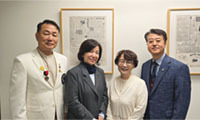▶ FRANK BRUNI
Last week I mentioned the movie “They Shoot Horses, Don’t They?” Only one of the 16 students had heard of it. I summarized its significance, riffling through the Depression, with which they were familiar, and Jane Fonda’s career, with which they weren’t. “Barbarella” went sailing over their heads. I didn’t dare test my luck with talk of leg warmers and Ted Turner.
I once brought up Vanessa Redgrave. Blank stares. Greta Garbo. Ditto. We were a few minutes into a discussion of an essay that repeatedly invoked Proust’s madeleine when I realized that almost none of the students understood what the madeleine signified or, for that matter, who this Proust fellow was.
And these are young women and men bright and diligent enough to have gained admission to Princeton University, which is where our disconnect is playing out.
The bulk of that disconnect, obviously, is generational. Seemingly all of my students know who Gwyneth Paltrow is. And with another decade or two of reading and living and being subjected to fossils like me, they’ll assemble a richer inventory of knowledge and trivia, not all of it present-day.
But the pronounced narrowness of the cultural terrain that they and I share ? the precise limits of the overlap ? suggests something additional at work. In a wired world with hundreds of television channels, countless byways in cyberspace and all sorts of technological advances that permit each of us to customize his or her diet of entertainment and information, are common points of reference dwindling? Has the personal niche supplanted the public square?
Both literally and figuratively, the so-called water-cooler show is fading fast, a reality underscored by a fact that I stumbled across in last week’s edition of The New Yorker: In the mid-1970s, when the sitcom “All in the Family” was America’s top-rated television series, more than 50 million people would tune in to a given episode. That was in a country of about 215 million.
I checked on the No. 1 series for the 2012-13 television season. It was “NCIS,” an episode of which typically drew fewer than 22 million people, even counting those who watched a recording of it within a week of its broadcast. That’s out of nearly 318 million Americans now.
“NCIS” competes against an unprecedented bounty of original programming and more ways to see new and old shows than ever, what with cable networks, subscription services, YouTube, Apple TV and Aereo. Yahoo just announced that it was jumping into the fray and, like Netflix and Amazon, would develop its own shows.
In movies, there’s a bevy of boutique fare that never even opens in theaters but that you can order on demand at home. In music, streaming services and Internet and satellite radio stations showcase a dizzying array of songs and performers, few of whom attain widespread recognition. In books, self-publishing has contributed to a marked rise in the number of titles, but it doesn’t take an especially large crowd of readers for a book to become a best seller. Everyone’s on a different page.
With so very much to choose from, a person can stick to one or two preferred micro-genres and subsist entirely on them, while other people gorge on a completely different set of ingredients. You like “Housewives”? Savor them in multiple cities and accents. Food porn? Stuff yourself silly. Vampire fiction? The vein never runs dry.
I brought up this Balkanization of experience with Hendrik Hartog, the director of the American studies program at Princeton, and he noted that what’s happening in popular culture mirrors what has transpired at many elite universities, where survey courses in literature and history have given way to meditations on more focused themes.
“There’s enormous weight given to specialized knowledge,” he said. “It leaves an absence of connective tissue for students.” Not for nothing, he observed, does his Princeton colleague Daniel Rodgers, an emeritus professor of history, call this the “age of fracture.”
It has enormous upsides, and may be for the best. No single, potentially alienating cultural dogma holds sway. A person can find an individual lens and language through which his or her world comes alive.
And because makers of commercial entertainment don’t have to chase an increasingly apocryphal mass audience, they can produce cultish gems, like “Girls” on HBO and “Louie” on FX.
But each fosters a separate dialect. Finding a collective vocabulary becomes harder. Although I’m tempted to tell my students that they make me feel like the 2,000-year-old man, I won’t. I might have to fill them in first on Mel Brooks.
스마터리빙
more [ 건강]
[ 건강]이제 혈관 건강도 챙기자!
[현대해운]우리 눈에 보이지 않기 때문에 혈관 건강을 챙기는 것은 결코 쉽지 않은데요. 여러분은 혈관 건강을 유지하기 위해 어떤 노력을 하시나요?
 [ 건강]
[ 건강]내 몸이 건강해지는 과일궁합
 [ 라이프]
[ 라이프]벌레야 물럿거라! 천연 해충제 만들기
 [ 건강]
[ 건강]혈압 낮추는데 좋은 식품
[현대해운]혈관 건강은 주로 노화가 진행되면서 지켜야 할 문제라고 인식되어 왔습니다. 최근 생활 패턴과 식생활의 변화로 혈관의 노화 진행이 빨라지고
사람·사람들
more많이 본 기사
- ‘패스트트랙 충돌’ 나경원·송언석·황교안 등 1심 유죄…벌금형
- 트럼프, 엡스타인 파일 공개법 서명… “민주당에 역풍 불것”
- 美, ‘中의존 탈피’ 위해 사우디와 희토류 공급망 추진
- 새 종전안으로 우크라이나 압박하는 트럼프…전선에선 공방 격화
- “트럼프, ‘AI규제 州법 무력화’ 추진…소송·예산지원 중단”
- 아이폰 있으면 국내선 여권 불필요 1
- 李대통령 “북핵 고도화 방치안돼…실용적·단계적 한반도비핵화”
- 무인도 좌초 여객선 항해사, 휴대전화 딴짓하다가 ‘쾅’
- “의회, 펠로시 주식 논란에 ‘국회 주식거래 금지법’ 본격 논의”
- 샬럿 대대적 불체자 단속에 한인사회 긴장
- ‘패스트트랙 충돌’ 1심유죄 벌금형…나경원 “정치항거 명분인정”
- 엔비디아 또 ‘사상최고’ 실적… ‘AI거품’ 논란 일축하고 주가↑
- 현빈♥손예진, 최초 부부 동반 남녀주연상..트로피 4개 집으로 [청룡영화상]
- 메디케이드·식량·주거 보조 이용… 영… 3
- 美, 중동에 엔비디아 최신칩 수출 승인…對韓수출 불확실성↓
- “무너진 캘리포니아 재건하겠다” 3
- ‘호객 없는 수산시장’… 제철 맞은 방어, 새우 먹으러 울진 간다
- 빈살만 극진환대 트럼프…영부인 만찬 … 1
- 트럼프, 조지아 단속에 “난 바보같이… 1
- 푸드스탬프 재신청 의무화 추진 300여만명 식비지원 상실 위기
- 한인은행 수익률… LA 카운티 은행 중위권 그쳐
- 호날두 직접 만난 美 대통령 “아들 앞에서 체면 살아” 농담... 일론 머스크·빈 살만과 함께 ‘백악관 만찬’
- 韓 사상 첫 ‘월드컵 포트2’ 확정, 문제는 ‘포트2답지 못한’ 홍명보호 경기력
- AI 확산에 올해 일자리 110만개 사라져
- “동양인 비하 제스처, 인종차별 맞다… 1
- 손흥민, ‘임신 협박 3억 갈취’ 20대女 재판에 ‘증인 출석’... 50분간 비공개 신문
- 실적낸 여성 뉴욕경찰수장, ‘진보’ … 1
- 타일러, ‘스타벅스’ 해프닝 언급→ 마케팅 제안 “내 이름 샌드위치 만들길”[라스]
- “소득대비 과도 공제… IRS 감사타겟 될 수도”
- 이젠 프리웨이도 달리는 웨이모
- “섬김과 연합으로 선한 영향력 전하는 총연 이끌 것”
- 홍명보호, 가나에 1-0 승리로 유종의 미… 내용은 아쉬워
- “美, 韓에 ‘디지털 규제 추진하면 무역법 301조 조사한다’ 경고”
- 李대통령 이집트 도착…對중동 정책 ‘카이로 구상’ 천명 주목
- 22기 뉴욕평통 출범식⋯“힘찬 출발”
- [경제 트렌드] “거스름 줄 동전이 없어”… 1센트 폐지 혼란
- 맥도널드, 연말 인기메뉴 ‘맥립’ 출시
- “미·러 새 종전안, 우크라 영토양보… 1
- ‘엡스타인파일 공개 법안’ 의회 문턱넘어…트럼프 서명만 남아
- ‘♥이용대 열애설’ 에이프릴 윤채경, 소나무 같은 취향? “이상형은 이민호”
- 슬기로운시니어생활 43회
- 사라진 백악관의 이스트 윙
- 젠슨황과 돈독해진 트럼프, 엔비디아 AI칩을 외교 카드로 활용
- VA 주지사 인수인계 ‘삐걱’…UVA 총장 선임 ‘격돌’
- [미국은 지금] 미국 정치의 파산과 그 댓가
- 계속되는 민주당의 헛손질
- 나경원 등 ‘패스트트랙 충돌’ 오늘 1심 선고…발생 6년7개월만
- 북VA 불법 마사지업소 260곳 넘는다
- 오프라인 한국어 과정 성공적 마무리 단계
- 메디케이드 받으면 영주권 신청 거부된다
1/5지식톡

-
 테슬라 자동차 시트커버 장착
0
테슬라 자동차 시트커버 장착
0테슬라 시트커버, 사놓고 아직 못 씌우셨죠?장착이 생각보다 쉽지 않습니다.20년 경력 전문가에게 맡기세요 — 깔끔하고 딱 맞게 장착해드립니다!장착비용:앞좌석: $40뒷좌석: $60앞·뒷좌석 …
-
 식당용 부탄가스
0
식당용 부탄가스
0식당용 부탄가스 홀세일 합니다 로스앤젤레스 다운타운 픽업 가능 안녕 하세요?강아지 & 고양이 모든 애완동물 / 반려동물 식품 & 모든 애완동물/반려동물 관련 제품들 전문적으로 홀세일/취급하는 회사 입니다 100% …
-
 ACSL 국제 컴퓨터 과학 대회, …
0
ACSL 국제 컴퓨터 과학 대회, …
0웹사이트 : www.eduspot.co.kr 카카오톡 상담하기 : https://pf.kakao.com/_BEQWxb블로그 : https://blog.naver.com/eduspotmain안녕하세요, 에듀스팟입니다…
-
 바디프렌드 안마의자 창고 리퍼브 세…
0
바디프렌드 안마의자 창고 리퍼브 세…
0거의 새제품급 리퍼브 안마의자 대방출 한다고 합니다!8월 23일(토)…24일(일) 단 이틀!특가 판매가Famille: $500 ~ $1,000Falcon: $1,500 ~ $2,500픽업 & 배송직접 픽업 가능LA…
-
 바디프렌드 안마의자 창고 리퍼브 세…
0
바디프렌드 안마의자 창고 리퍼브 세…
0거의 새제품급 리퍼브 안마의자 대방출 한다고 합니다!8월 23일(토)…24일(일) 단 이틀!특가 판매가Famille: $500 ~ $1,000Falcon: $1,500 ~ $2,500픽업 & 배송직접 픽업 가능LA…
케이타운 1번가
오피니언
 정숙희 논설위원
정숙희 논설위원사라진 백악관의 이스트 윙
 파리드 자카리아 워싱턴포스트 칼럼니스트 / CNN ‘GPS’ 호스트
파리드 자카리아 워싱턴포스트 칼럼니스트 / CNN ‘GPS’ 호스트 계속되는 민주당의 헛손질
 김동찬 시민참여센터 대표
김동찬 시민참여센터 대표 [미국은 지금] 미국 정치의 파산과 그 댓가
 성영라 수필가 미주문협 부이사장
성영라 수필가 미주문협 부이사장 [수요 에세이] 부석사, 배흘림기둥에 기대어 보다
 서정명 / 서울경제 논설위원
서정명 / 서울경제 논설위원[만화경] ‘국부론’과 “기업이 곧 국력”
 노세희 부국장대우·사회부장
노세희 부국장대우·사회부장 대한은 다시 살아나는가
 민경훈 논설위원
민경훈 논설위원사자와 생쥐, 그리고 인간 이야기
 한형석 사회부 부장대우
한형석 사회부 부장대우 한인타운 교통 인프라 개선 기대
 박영실 시인·수필가
박영실 시인·수필가 [화요칼럼] 말의 위력
1/3지사별 뉴스

22기 뉴욕평통 출범식⋯“힘찬 출발”
22기 민주평화통일자문회의 뉴욕협의회(회장 이시화)는 17일 퀸즈 플러싱 소재 코리아빌리지 디모스 연회장에서 자문위원 173명을 비롯한 한인사…
메디케이드 받으면 영주권 신청 거부된다

VA 주지사 인수인계 ‘삐걱’…UVA 총장 선임 ‘격돌’
버지니아 글렌 영킨(Glenn Youngkin, 공화, 사진 왼쪽) 주지사와 내년 1월 취임하는 아비가일 스팬버거(Abigail Spanber…
북VA 불법 마사지업소 260곳 넘는다

오프라인 한국어 과정 성공적 마무리 단계
샌프란시스코 한국 교육원(허혜정 원장)이 2025년 가을 학기에 처음 개설한 오프라인 한국어 과정 ‘한국어 1’이 오는 22일 성공적인 마무리…
마라나타 비전교회, 장로/안수집사 임직및 장로 은퇴예배

오늘 하루 이 창 열지 않음 닫기 





















































.png)


댓글 안에 당신의 성숙함도 담아 주세요.
'오늘의 한마디'는 기사에 대하여 자신의 생각을 말하고 남의 생각을 들으며 서로 다양한 의견을 나누는 공간입니다. 그러나 간혹 불건전한 내용을 올리시는 분들이 계셔서 건전한 인터넷문화 정착을 위해 아래와 같은 운영원칙을 적용합니다.
자체 모니터링을 통해 아래에 해당하는 내용이 포함된 댓글이 발견되면 예고없이 삭제 조치를 하겠습니다.
불건전한 댓글을 올리거나, 이름에 비속어 및 상대방의 불쾌감을 주는 단어를 사용, 유명인 또는 특정 일반인을 사칭하는 경우 이용에 대한 차단 제재를 받을 수 있습니다. 차단될 경우, 일주일간 댓글을 달수 없게 됩니다.
명예훼손, 개인정보 유출, 욕설 등 법률에 위반되는 댓글은 관계 법령에 의거 민형사상 처벌을 받을 수 있으니 이용에 주의를 부탁드립니다.
Close
x